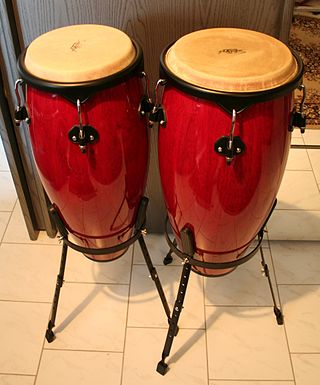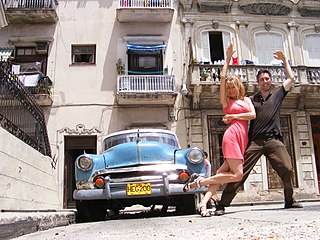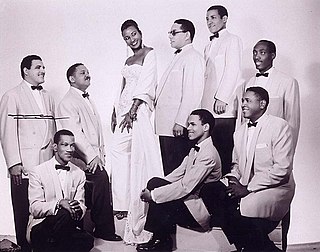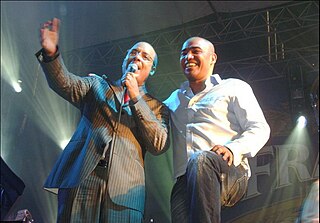
Salsa music is a style of Latin American music, combining elements of Cuban, Puerto Rican, and American influences. Because most of the basic musical components predate the labeling of salsa, there have been many controversies regarding its origin. Most songs considered as salsa are primarily based on son montuno and son cubano, with elements of guaracha, cha-cha-chá, danzón, descarga, bolero, guajira, rumba, mambo, jazz, funk, R&B, rock, bomba, and plena. All of these elements are adapted to fit the basic Son montuno template when performed within the context of salsa.

Ronald James Padavona, known professionally as Ronnie James Dio, was an American heavy metal singer. He fronted numerous bands throughout his career, including Elf, Rainbow, Black Sabbath, Dio and Heaven & Hell.

Úrsula Hilaria Celia de la Caridad Cruz Alfonso, known as Celia Cruz, was a Cuban singer and one of the most popular Latin artists of the 20th century. Cruz rose to fame in Cuba during the 1950s as a singer of guarachas, earning the nickname "La Guarachera de Cuba". In the following decades, she became known internationally as the "Queen of Salsa" due to her contributions to Latin music. She had sold over 10 million copies, making her one of the best-selling Latin music artists.

Carlos Alberto Vives Restrepo is a Colombian singer, songwriter and actor. He is known for his interpretation of traditional music styles of Colombia such as vallenato, cumbia, champeta, bambuco and porro as well as genres such as Latin pop, reggaeton, dance pop and tropical music.
The music of Cuba, including its instruments, performance, and dance, comprises a large set of unique traditions influenced mostly by west African and European music. Due to the syncretic nature of most of its genres, Cuban music is often considered one of the richest and most influential regional music in the world. For instance, the son cubano merges an adapted Spanish guitar (tres), melody, harmony, and lyrical traditions with Afro-Cuban percussion and rhythms. Almost nothing remains of the original native traditions, since the native population was exterminated in the 16th century.

Buena Vista Social Club was a musical ensemble primarily made up of Cuban musicians, formed in 1996. The project was organized by World Circuit executive Nick Gold, produced by American guitarist Ry Cooder and directed by Juan de Marcos González. They named the group after the members' club of the same name in the Buenavista quarter of Havana, a popular music venue in the 1940s. To showcase the popular styles of the time, such as son, bolero and danzón, they recruited a dozen veteran musicians, some of whom had been retired for many years.

Los Van Van is one of the leading musical groups of post-revolutionary Cuba. It was founded in 1969 by bassist Juan Formell, who directed the band until his death in 2014. Formell and former band members Changuito and Pupy are some of the most important figures in contemporary Cuban music, having contributed to the development of songo and timba, two popular dance music genres.

Héctor Juan Pérez Martínez, better known as Héctor Lavoe, was a Puerto Rican salsa singer. Lavoe is considered to be possibly the best and most important singer and interpreter in the history of salsa music because he helped to establish the popularity of this musical genre in the decades of 1960s, 1970s and 1980s. His personality, style and the qualities of his voice led him to a successful artistic career in the whole field of Latin music and salsa during the 1970s and 1980s. The cleanness and brightness of his voice, coupled with impeccable diction and the ability to sing long and fast phrases with total naturalness, made him one of the favorite singers of the Latin public.

Omara Portuondo Peláez is a Cuban singer and dancer. A founding member of the popular vocal group Cuarteto d'Aida, Portuondo has collaborated with many important Cuban musicians during her long career, including Julio Gutiérrez, Juanito Márquez and Chucho Valdés. Although primarily known for her rendition of boleros, she has recorded in a wide range of styles from jazz to son cubano. Since 1996, she has been part of the Buena Vista Social Club project, touring extensively and recording several albums with the ensemble. She won a Latin Grammy Award for Best Contemporary Tropical Album in 2009, a Latin Grammy Award for Best Traditional Tropical Album in 2023, a Latin Grammy Lifetime Achievement Award in 2019, and she received three Grammy Award nominations in 2019 and a nomination in 2024.

Timba is a Cuban genre of music based on Cuban son with salsa, American R&B/Funk and the strong influence of Afro-Cuban folkloric music. Timba rhythm sections differ from their salsa counterparts, because timba emphasizes the bass drum, which is not used in salsa bands. Timba and salsa use the same tempo range and they both use the standard conga marcha. Almost all timba bands have a trap drummer. Timbas also often break the basic tenets of arranging the music in-clave. Timba is considered to be a highly aggressive type of music, with rhythm and "swing" taking precedence over melody and lyricism. Associated with timba is a radically sexual and provocative dance style known as despelote. It is a dynamic evolution of salsa, full of improvisation and Afro Cuban heritage, based on son, Rumba and mambo, taking inspiration from Latin jazz, and is highly percussive with complex sections. Timba is more flexible than salsa and includes a more diverse range of styles. Timba incorporates heavy percussion and rhythms which originally came from the barrios of Cuba.

A backing vocalist is a singer who provides vocal harmony with the lead vocalist or other backing vocalists. A backing vocalist may also sing alone as a lead-in to the main vocalist's entry or to sing a counter-melody. Backing vocalists are used in a broad range of popular music, traditional music, and world music styles.

La Sonora Matancera is a Cuban band that played Latin American urban popular dance music. Founded in 1924 and led for more than five decades by guitarist, vocalist, composer, and producer Rogelio Martínez, musicologists consider it an icon of this type of music. Notable singers to have sung and recorded with the band include Bienvenido Granda, Daniel Santos, Myrta Silva, Miguelito Valdés, Leo Marini, Celia Cruz, Nelson Pinedo, Vicentico Valdés, Estanislao "Laíto" Sureda, Alberto Beltrán, Carlos Argentino, and Celio González.
Pellín Rodríguez was a Salsa singer. Rodríguez was a member of the musical group El Gran Combo and toured with them all over Latin America and Europe, gaining fame and popularity as a singer. In addition to his singing capabilities, Rodríguez had great comedic abilities and participated on comedy bits on various TV shows in Puerto Rico.

Michael H. McDonald is an American singer, keyboardist and songwriter known for his distinctive, soulful voice and as a member of Steely Dan (1973–1974), and the Doobie Brothers. McDonald wrote and sang several hit singles with the Doobie Brothers, including "What a Fool Believes", "Minute by Minute", and "Takin' It to the Streets." McDonald has also performed as a prominent backing vocalist on numerous recordings by artists including Steely Dan, Christopher Cross, and Kenny Loggins.

Dilana Smith is a South African singer, songwriter, and performer who lives in Los Angeles, California. She is best known as the runner-up contestant on the CBS reality television show Rock Star: Supernova. She was the lead singer for Tracii Guns' version of L.A. Guns for a brief period in 2011.
Brooklyn Dreams were an American singing group of the late 1970s, mixing R&B harmonies with contemporary dance/disco music and best known for a number of collaborations with singer Donna Summer. The band consisted of Joe "Bean" Esposito, Eddie Hokenson and Bruce Sudano. Esposito provided lead vocals for the band and played guitar, while Sudano played keyboards and Hokenson played drums and occasionally sang lead vocals.

Issac Delgado is one of the founders of the band NG La Banda and is a popular salsa and timba performer.

"Cielito Lindo" is a Mexican folk song or copla popularized in 1882 by Mexican author Quirino Mendoza y Cortés. It is roughly translated as "Lovely Sweet One". Although the word cielo means "sky" or "heaven", it is also a term of endearment comparable to "sweetheart" or "honey". Cielito, the diminutive, can be translated as "sweetie"; lindo means "cute", "lovely" or "pretty". The song is commonly known by words from the refrain, "Canta y no llores", or simply as the "Ay, Ay, Ay, Ay song".

The Sexteto Habanero was a Cuban son sextet founded in 1920 in Havana. It played an important part in the early history of the genre, contributing to its popularization all around Cuba. In 1927, the band incorporated a cornet player becoming the Septeto Habanero. Although most original members left in the 1930s, the band has continued to perform and record with different line-ups. Their last album was released in 2010 for their 90th anniversary.
Raimunda Paula Peña Álvarez, better known as Paulina Álvarez, was a renowned Cuban singer of danzonetes. She became the leading exponent of the genre during the 1930s, being nicknamed La Emperatriz del Danzonete. Her greatest hit was the song "Rompiendo la rutina", the first danzonete, composed by Aniceto Díaz in 1929. In 1960 she recorded her only LP record.
















